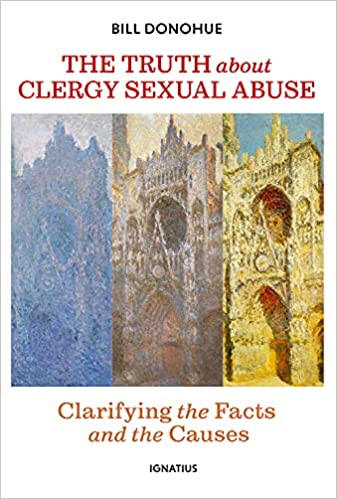Catholic Medical Quarterly Volume 72 (3) August 2022
Book Review
The Truth about Clergy Sexual Abuse:
Clarifying the Facts and the Causes
by Bill Donohue
Ignatius Press
 The
author is president of the Catholic League for Religious and Civil Rights.
He also has a Ph.D in sociology. As such, he is in a good position to
discuss one of the greatest crises in the Catholic Church. It is a
remarkable and timely work.
The
author is president of the Catholic League for Religious and Civil Rights.
He also has a Ph.D in sociology. As such, he is in a good position to
discuss one of the greatest crises in the Catholic Church. It is a
remarkable and timely work.
It is said in certain circles that the Catholic Church is riddled with pedophile priests. Not so, say the author. While there was a problem of priests abusing mainly male adolescents a couple of decades ago, the problem has been largely resolved by appropriate steps taken. Not all homosexual priests are abusers. But most abusers in the Catholic Church are homosexual, says the author. From the mid-sixties to the eighties, the problem increased. It has been decreasing since. What happened in the sixties? The Church opened its windows to let in all the filth of secular sixties culture, says the author. Too many seminaries taught the students to experiment with sexuality. The word chastity was (he says) largely forgotten.
It could be argued that the author unjustly focusses on the issue of homosexuality. However, he notes that eight in ten cases of clergy abuse involves males abusing males, the victims mainly being post pubescent males. This is a remarkably high number in comparison to the wider society where most abusers are males abusing females.
Bill Donoghue writes movingly that the scandal could not have happened if men who were already troubled or disordered were not given the rationale to do so. He says that those who provided the rationale were Church dissidents. He says that beginning in the late 1960s, many seminaries became hotbeds of dissent. Many Catholic dissidents were in open rebellion against the Church’s teachings on sexuality. Similarly Catholic colleges and universities were infected with dissent, and (he says) many still are. The author demonstrates that dissent, and the disruption of authority that comes with it, leads to clergy sexual abuse. I myself, recall hearing about dysfunctional seminaries back in the eighties. Seminarians told me they were in trouble because they were deemed too conservative and too rigid. Seminaries were more interested in rigidity tests than making sure that their students would make good priests.
It could be argued that celibacy is a causative factor. It is not, says the author. Plenty of denominations where clergy can get married have been in the news because of clergy sexual abuse. Also, rates of Catholic clergy abuse were low before the sixties.
The author points out that while there is every need for vigilance, 99.9% of Catholic clergy in the United States have not been charged with sexual misdemeanours in the last few years.
As well as that he reminds us that while priestly abuse is an appalling crime, we should not ignore the many problems elsewhere: in dysfunctional families, in health and social care agencies, in schools and in sports for example.
There is every need to be vigilant.The author of this excellent book reminds us of the importance of solid priestly formation. This must remain an ongoing concern.
